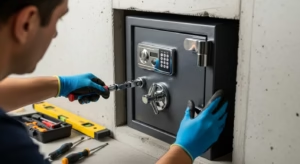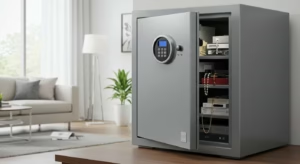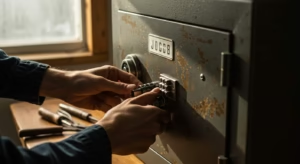Safes are an important part of a home and office to secure your valuable possessions, including documents, jewelry, cash, and a lot more. They provide you peace of mind, knowing your valuables are protected against theft, fire, and natural disasters. Just like any other tool or mechanical device, safe can develop issues that repair services. If you notice any issues, get safe services in NYC to ensure its best functionality.
Today, we will be discussing common issues that require safe repair in NYC.
Lock Malfunctions
Lock issues are among the most frequent problems requiring safe repair in NYC. Modern safes use a variety of locking mechanisms, including traditional key locks, combination locks, and electronic keypads. Each type of lock has its unique vulnerabilities:
- Key Locks: Over time, keys can bend, break, or wear down, leading to difficulties in unlocking the safe. Similarly, the internal components of the lock may degrade due to wear and tear.
- Combination Locks: Combination locks can develop alignment problems in their internal gears. A slight misalignment can prevent the lock from opening even with the correct combination.
- Electronic Keypads: These are prone to battery failure, circuit board malfunctions, or wear on the keypad itself. Corroded or loose wiring can also disrupt the operation of the electronic lock.
Forgotten Combinations or Lost Keys
Human error is a common reason for safe repair. Losing a key or forgetting the combination is more frequent than one might think. Many safe owners fail to record or securely store their safe’s key or combination, leading to lockouts. In such cases, professional locksmiths or safe technicians are often required to bypass or reset the lock without damaging the contents.
Also Read: How to Properly Maintain and Care for Your Safe
Safe Door Misalignment
Safe doors are engineered to fit tightly, providing maximum security. However, they can become misaligned due to improper handling, frequent use, or external impacts. Misaligned doors are difficult to open or close and may even compromise the safe’s security by creating gaps that could be exploited by potential intruders. This issue often requires adjustment or repair of the hinges, bolts, or door frame to restore proper alignment.
Bolt Work Problems
The bolts in a safe are essential for securing the door. These mechanisms can become jammed due to rust, debris, or mechanical failure. In some cases, the bolts may not fully extend or retract, making it impossible to lock or unlock the safe. Repairing bolt work often involves cleaning, lubricating, or replacing the affected parts.
Damage from Attempted Break-Ins
If a safe has been targeted in a burglary attempt, it may sustain physical damage that requires professional repair. Thieves often use tools like drills, crowbars, or cutting equipment in their attempts to breach a safe. Even if the safe remains secure, the lock, door, or hinges might be compromised, necessitating immediate attention to ensure the safe’s continued reliability.
Fire or Water Damage
Many safes are designed to withstand fire and water to varying degrees. However, extreme conditions can still cause significant damage. Prolonged exposure to heat may warp the metal structure or damage the lock mechanism. Similarly, water from flooding, firefighting efforts, or leaks can corrode internal components and weaken the safe’s protective properties. Repairs in such cases often involve restoring or replacing affected parts and re-sealing the safe.
Battery and Power Issues
For safes equipped with electronic locks, battery and power issues are common. Dead or dying batteries can prevent the lock from functioning, leaving the safe inaccessible. Many safes have external battery access, but others require the expertise of a technician to open the safe and replace the power source. In more severe cases, issues with the internal circuitry or wiring may also require repair.
Mechanical Wear and Tear
Safes are built to last, but they are not immune to the effects of time and usage. Regular opening and closing, exposure to environmental elements, and aging materials can lead to wear and tear. Hinges may rust or loosen, locking mechanisms may lose precision, and structural components may weaken. Periodic maintenance and repair can extend the life of a safe and ensure its reliability.
Incorrect Installation
Improper installation is a less obvious but significant cause of safe issues. If a safe is not installed correctly, it may develop functional problems over time. For example, uneven surfaces can cause the safe to tilt, leading to door misalignment or undue stress on the locking mechanism.
Factory Defects
Although rare, factory defects can occur in safes, particularly in lower-quality models. These defects may include poorly aligned components, substandard materials, or faulty locking mechanisms. If a safe exhibits problems soon after purchase, it’s essential to contact the manufacturer or a repair technician to address these issues under warranty.
The Role of Professionals in Handling Safe Repairs in NYC
While some minor issues, such as replacing batteries or cleaning gaskets, can be handled by safe owners, most problems require the expertise of a professional. At City Safe and Vault, our experts have the right tools and equipment to provide complete, safe repair services in NYC. They have the knowledge and expertise to fix and install any type of safe. Our team can fix all types of safe problems, including:
- Bypass locks can be used without damaging the safe or its contents.
- Realign doors and repair structural components.
- Replace or retrofit outdated or damaged locks.
- Restore safes affected by fire, water, or burglary attempts.
- Perform routine maintenance to prevent future problems.
Ready to schedule an appointment for safe services in NYC? Contact us now





